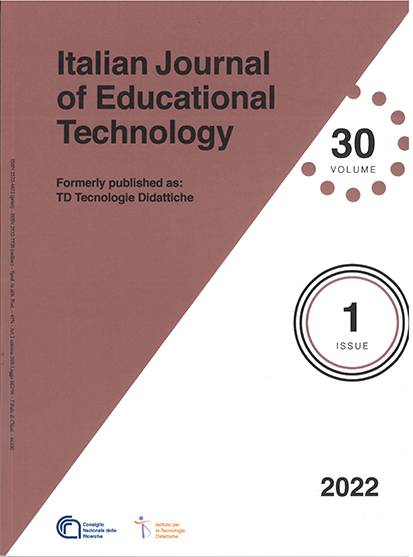EDITORIAL. A PEDAGOGY OF CARE: CRITICAL HUMANIZING APPROACHES TO TEACHING AND LEARNING WITH TECHNOLOGY
Main Article Content
Abstract
In this introduction to the special issue on “A pedagogy of care”, we, the special issue editors, share our own critical approaches to humanizing teaching with technology in the past few years – going back to before the pandemic – that led to the special issue. As the world “pivoted online”, and technology was taken for granted as essential in education, we, along with critical scholars, pushed back against dominant assertions about how central technology would be in teaching and learning contexts. Identifying the need to address care in a time when neoliberalism has normalized the involvement of big tech in education, reflecting on the pandemic, this issue includes seven articles (including this introduction) covering a range of national and international perspectives on care, including critiques of digital technology; recognition of emotional labor; connecting/curating resources for teachers; the importance of cultivating a sense of purpose; moving past binary thinking; and linking care and equity. Across all seven articles, we focus on the act of caring–imagining education as a process of love, community, and attention.
Article Details
Section
Authors who publish with this journal agree to the following terms:
- Authors retain copyright and grant the journal right of first publication with the work simultaneously licensed under a Creative Commons CC BY 4.0 Attribution 4.0 International License.
- Authors are able to enter into separate, additional contractual arrangements for the non-exclusive distribution of the journal's published version of the work (e.g., post it to an institutional repository or publish it in a book), with an acknowledgement of its initial publication in this journal.
- Authors are permitted and encouraged to post their work online (e.g., in institutional repositories or on their website) prior to and during the submission process, as it can lead to productive exchanges, as well as earlier and greater citation of published work (See The Effect of Open Access)
References
Feng, L., Hu, Y., Li, B., Stanley, H. E., Havlin, S., & Braunstein, L. A. (2015). Competing for attention in social media under information overload conditions. PLOS ONE, 10(7). doi: 10.1371/journal.pone.0126090
hooks, b. (2003). Teaching community: A pedagogy of hope (Vol. 36). London, UK: Routledge.
Krutka, D. G., Heath, M. K., & Mason, L. E. (2020). Technology won’t save us–A call for technoskepticism in social studies. Contemporary Issues in Technology and Teacher Education, 20(1), 108-120.
By Kevin R. McClure, K. R., & Fryar, A. H. (2022). The Great Faculty Disengagement. The Chronicle of Higher Education, January 19, 2022. Retrieved from https://www.chronicle.com/article/the-great-faculty-disengagement
McMillan Cottom, T. (2016). Black Cyberfeminism: Intersectionality, Institutions and Digital Sociology. SRPN: Information Technology (Topic).
Mehta, R., & Aguilera, E. (2020). A critical approach to humanizing pedagogies in online teaching and learning. The International Journal of Information and Learning Technology, 37(3), 109-120.
Mehta, R., Creely, E., & Henriksen, D. (2020). A profitable education: Countering neoliberalism in 21st century skills discourses. In Keengwe J. & Onchwari G. (Eds.), Handbook of Research on Literacy and Digital Technology Integration in Teacher Education (pp. 359-381). Hershey, PA, US: IGI Global.
Mehta, R., Henriksen, D., & Mishra, P. (2020). “Let children play!”: Connecting evolutionary psychology and creativity with Peter Gray. TechTrends, 64(5), 684-689.
Michaeli, I. (2017). Self-Care: An act of political warfare or a neoliberal trap? Development, 60, 50–56.
Nakkula, M. J., & Ravitch, S. M. (1998). Matters of interpretation: Reciprocal transformation in therapeutic and developmental relationships with youth. San Francisco, CA, US: Jossey-Bass.
Noddings, N. (2005). What does it mean to educate the whole child? Educational leadership, 63(1), 8-13.
Noddings, N. (2013). Caring: A relational approach to ethics and moral education. Berkeley, CA, US: University of California Press.
Olson, K. (2009). Wounded by School: Recapturing the Joy in Learning and Standing Up to Old School Culture. New York, NY, US: Teachers College Press.
Rabin, C. (2013). Care through authenticity: Teacher preparation for an ethic of care in an age of accountability. The Educational Forum, 77(3), 242-255.
Rolón-Dow, R. (2005). Critical care: A color(full) analysis of care narratives in the schooling experiences of Puerto Rican girls. American Educational Research Journal, 42(1), 77-111.
Rose, E., & Adams, C. A. (2014). “Will I ever connect with the students?”. Online teaching and the pedagogy of care. Phenomenology & Practice, 7(2), 5-16.
Rosen, C. (2008). The myth of multitasking. The New Atlantis, 20, 105-110.
Roy, A. (2020, April 3). The pandemic is a portal. Financial Times. Retrieved from https://www.ft.com/content/10d8f5e8-74eb-11ea-95fe-fcd274e920ca
Shelton, C., Aguilera, E., Gleason, B., & Mehta, R. (2020). Resisting dehumanizing assessments: Enacting critical humanizing pedagogies in online teacher education. In R.E. Ferdig, E. Baumgartner, R. Hartshorne, R. Kaplan-Rakowski, & C. Mouza (Eds.), Teaching, technology, and teacher education during the COVID-19 pandemic: Stories from the field (pp.125-128). AACE-Association for the Advancement of Computing in Education.
Thiele, K., Górska, M., & Türer, P. (2020). Relation(al) matters: Vulnerable pedagogies, care and carriance as (c) air-ful (l) ness in higher education. In V. Bozalek, M. Zembylas, & J. C. Tronto (Eds.), Posthuman and Political Care Ethics for Reconfiguring Higher Education Pedagogies (pp. 51-64). London, UK: Routledge.
Zygmunt, E., Cipollone, K., Tancock, S., Clausen, J., Clark, P., & Mucherah, W. (2018). Loving out loud: community mentors, teacher candidates, and transformational learning through a pedagogy of care and connection. Journal of Teacher Education, 69(2), 127–139. doi: 10.1177/0022487117751640

